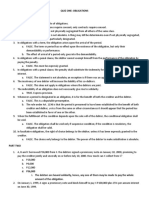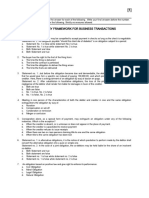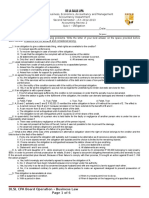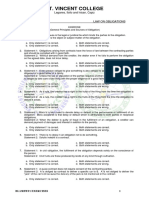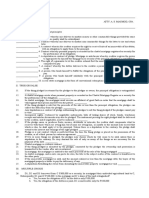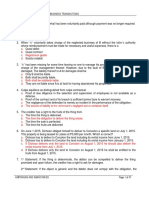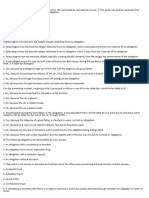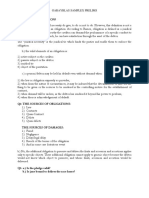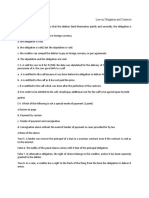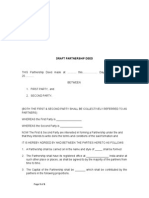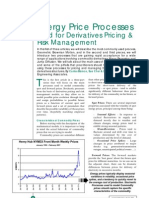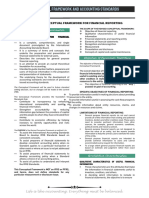Obligations
Obligations
Uploaded by
Charrie Grace PabloCopyright:
Available Formats
Obligations
Obligations
Uploaded by
Charrie Grace PabloOriginal Description:
Copyright
Available Formats
Share this document
Did you find this document useful?
Is this content inappropriate?
Copyright:
Available Formats
Obligations
Obligations
Uploaded by
Charrie Grace PabloCopyright:
Available Formats
Pa ge |1
BUSINESS LAW
Atty. Al Macmod
OBLIGATIONS - 01
I. Identification (Basic Concept/Principles)
______________
1.
______________
______________
______________
2.
3.
4.
______________
______________
______________
______________
______________
5.
6.
7.
8.
9.
______________
10.
______________
______________
______________
______________
11.
12.
13.
14.
______________
______________
______________
______________
______________
______________
15.
16.
17.
18.
19.
20.
Natural or juridical susceptible of being the subject of legal
relations.
The fitness to be the subject of legal relations.
The power to do acts with legal effects.
Rule of conduct promulgated by legislative power and obligatory
to all.
Incorporated to the principal naturally or artificially.
Added to the principal for its completeness.
Non-compliance of obligation when it falls due.
The thing perishes with the owner rule.
Negligence where there is no existing contract between the
parties.
Deliberate act of evading the normal compliance of an
obligation.
One in which a debtor may validly pay a monetary obligation.
Means no partial payment or performance is allowed.
Debtor abandons all his property to his creditors for them to sell.
The deposit of a thing in legal form when the creditor refuses to
accept or cannot receive it.
The legal basis of quasi-contracts.
One person becomes the debtor and creditor of himself.
Two persons became debtor and creditor of each other.
Gratuitous abandonment by the creditor of his rights.
Change in the subject of an obligation.
Extinguishment of obligation by passage of time.
KINDS OF OBLIGATIONS:
______________
21.
______________
______________
a. Not legally enforceable. / in accordance with natural law.
b. Legally enforceable. / in accordance with positive law.
c. In accordance with both natural and positive law.
______________
22.
______________
______________
24.
a. Obligation governed by the Civil Code.
b. Obligation governed by the Code of Commerce and other
special laws.
a. An obligation without a condition or terms.
b. An obligation whose efficacy depends of the fulfillment, or
non- fulfillment of a future and uncertain event.
c. An obligation subject to a term.
a. In either case, the obligation is demandable at once.
______________
______________
23.
______________
25.
a. Obligation wherein only one party is liable.
______________
b.Obligation wherein obligation is pro-rated among the
parties.
______________
c. Obligation wherein each party is entitled to or liable for the
entire obligation.
a. Where only one prestation is involved.
b.Where all prestation are due and demandable.
c. Where only one of the several prestations due had to be
preformed.
d. Where one prestation is due but may be substituted by the
debtor with another
a. An obligation to give.
b. An obligation to do or not to do.
______________
______________
______________
26.
______________
______________
______________
27.
______________
______________
28.
a.An obligation capable of partial performance.
b.An obligation incapable of partial performance.
______________
______________
29.
a. An obligation based on law.
b. An obligation based on the agreement of the parties.
Pa ge |2
______________
______________
30.
a. Can stand alone.
b. Depends on another obligations.
II. TRUE OR FALSE
31. Contract is the effect, while the obligation is the cause.
32. D obliged himself to give C P1,000,000 if the latter would not kill X, a third person. In this
case, both the condition as well as the obligation are void.
33. In alternative obligation all things are due just like facultative obligation.
34. In a solidary obligation the remission of the whole debt is a donation to all the debtors.
35. In facultative obligation the right to choose can be given to the creditor.
36. A person civily liable is also criminally liable.
37. Every person obliged to give something is also obliged to take care of it with due diligence of
a good father of a family always.
38. The creditor has the right to the fruits of the thing from the time the obligation is constituted.
39. An obligation subject to resolutory condition is demandable regardless of the effects of the
happening of the event.
40. Payment made by the debtor to a third person who is not the creditor will not extinguish the
obligation.
41. Any waiver of an action for future fraud if done voluntarily by parties is valid.
42. An obligation payable as soon as possible is an obligation with a period for the benefit the
creditor only.
43. D obliged himself to pay C the sum of P50,000 which he owes him when he (D) feels like it.
This kind of obligation is valid and legally enforceable.
44. Solidarity may be presumed just like in joint obligations.
45. Condonation is generally gratuitous.
46. Whoever pays on behalf of the debtor with or without his knowledge can compel the creditor
to subrogate him.
47. Dation in payment is an exception to the rule on indivisibility of payment.
48. In delegacion, the new debtors insolvency may revive the original debtors obligation.
49. Negotiorum gestio is a contract based on the principle of unjust enrichment.
50. When a debtor voluntarily pays an obligation that has prescribed already, he may still recover
under the rule governing natural obligations.
51.
A source of obligation where negligence resulted to crime:
a. culpa contractual
b. quasi-contract
c. culpa delictual
d. culpa aquiliana
52.
Which is not a source of obligation?
a. Law
b. Culpa Aquilana
c. Culpa Contractual
d. Quasi Contract
53.
Statement No. 1: D oblige himself to give C a specific car tomorrow. If D failed to deliver
tomorrow after demand is made C may compel D to do his obligation and may ask for
damages.
Statement No. 2: D oblige himself to deliver a car to C tomorrow. If D failed to deliver
tomorrow after demand is made C's right is to ask a third person to deliver a car to him at
the expense of D plus damage.
a. Both are true
b. Both are false
c. No. 1 is true; No. 2 is false
d. No. 1 is false; No 2 is true
54.
Which of the following is considered as quasi-contract?
a. Solutio indebiti
b. When the third person, without the knowledge of the debtor, pays the debt
c. Reimbursement due the person who saved property during fire or storm without
the knowledge of the owner.
d. All of the above.
Pa ge |3
55.
A judicial relation known as Negotiorum Gestio takes place.
a. When a person voluntarily takes charge of another's abandoned business or
property without the owner's consent.
b. When something is received and there is no right to demand it and it was
delivered through mistake.
c. When a person is appointed by a court to take the property or business of
another.
d. None of the above.
56.
The wrongful act or tort which causes loss or harm to another is called:
a. Damages
b. Damage
c. Injury
d. Liability
57.
Which of the following is not a generic obligation?
a. obligation to pay P5,000
b. obligation to deliver Toyota INNOVA 2005
c. obligation to deliver 50 cavans of rice
d. obligation to give a delimited generic object
58.
Statement No. 1: An obligation which has for its object the delivery of a "delimited generic"
object may be lost by reason of fortuitous e3vent.
Statement No. 2: There can be no delay in an obligation not to do.
a. Both statement are true
b. Both statements are false
c. Statement No. 1 is true while statement NO.2 is false
d. Statement No. 1 is false while statement No. 2 is true
59.
If the obligation is payable in foreign currency
a. the obligation is void.
b. the obligation is valid, but the stipulation is void.
c. the creditor can compel the debtor to pay in foreign currency as per agreement.
d. The stipulation and the obligation are void.
60.
"I'll give you my car one year after your death." The obligation is
a. valid, because the event is sure to come.
b. valid, the obligation is conditional.
c. valid, but disregard the condition.
d. void, not legally possible.
61.
Statement No. 1: The concurrence of more than one creditor or more than one debtor in
one and the same obligation implies solidarity.
Statement No. 2: In alternative obligations where the right of choice is exercised by the
creditor, consent of the debtor as to the creditor's choice of which prestation to perform is
necessary.
a. Both statements are true
b. Both statements are false
c. Statement No, 1 is true while statement NO.2 is false
d. Statement No. 1 is false while statement NO.2 is true
62.
Statement NO. 1: "I will give you a NOKIA 6610 Phone if you will not marry X this year
(2012). If by the end of 2012, both parties are alive and no marriage has taken place, my
obligation is extinguished.
Statement NO. 2: "I will give you P10,000 if I decide to go to Cebu City tomorrow. This
obligation is valid.
a. Both are true
b. Both are false
c. No. 1 is true; No. 2 is false
d. No. 1 is false; NO.2 is true
63.
Statement NO. 1: If the obligation does not fix a period, but from its nature and the
circumstances, it can be inferred that a period was intended, the court may fix the duration
thereof. Once it is fixed by the court the parties cannot change the fixed date for
performance.
Statement NO. 2: "I will give you P10,000 if X dies next year." This is an obligation with a
period.
a. Both are true
b. Both are false
c. No. 1 is true; No. 2 is false
d. No. 1 is false; No. 2 is true
Pa ge |4
64.
Which obligation is not valid?
a. "I promise to give you P100,000 on December 25, 2012"
b. "I promise to give you P100,000 if my mood dictates".
c. "I Promise to give you P100,000 if your patient dies".
d. "I promise to give you P100,000 if you pass the May 2013 CPA Board
Examination."
65.
Which of the following is an obligation with a period for the benefit of both the debtor and
the creditor?
a. Payable if I like
b. Payable when you like
c. Payable on or before December 25, 2012
d. Payable on December 24, 2012
66.
Which of the following obligations is not subject to a period?
a. payable soonest
b. payable "little by little"
c. payable whenever "I like it"
d. payable "when my means permits me to"
67.
A and B signed a promissory note to borrow P6,000 from X, Y and Z, payable in 6 months
time. B gave in pledge a P10,000 diamond ring as security for the amount borrowed. How
much can Y collect from B?
a. P1,000
b. P6,000
c. P2,000
d. P3,000
68.
If in the situation given above, the diamond ring is returned by agreement to B, which of the
following statement is correct?
a. Principal obligation is extinguished
b. Only P2,000 of the obligation is extinguished
c. Only P3,000 of the obligation is extinguished
d. Accessory obligation is extinguished.
69.
A, Band C executed a promissory note worded as follows:
We promise to pay X, Y and Z the sum of P90,000
(Sgd,) A, B and C
a. A is obliged to pay to X, Y and Z P90,000
b. A is obliged to pay X P30,000
c. A is obliged to pay X P60,000
d. A is obliged to pay X P10,000
70.
Statement No. 1: When the fulfillment of the suspensive or resolutory condition depends
upon the sole will of the debtor, the conditional obligation shall be void.
Statement No. 2: If the original obligation is subject to a suspensive or resolutory condition
and the contract is novated the new obligation shall be under the same conditions unless
otherwise stipulated.
a. Both are true
b. Both are false
c. No. 1 is true; No. 2 is false
d. No.1 is false; No. 2is true
71.
In contracts and quasi-contracts, the liability of the debtor who acted in good faith:
a. Extends to all natural and probable consequences of the breach of the obligation,
and which the parties have foreseen or could have reasonably foreseen at the
time the obligation was constituted.
b. Extends only to results intended but excluding exemplary damages.
c. Extends to all damages which may be reasonably attributable to the
nonperformance of the obligation.
d. Extends to all damages which may be renounced in advanced
72.
Statement No. 1: In solution indebiti, damages in case of non-compliance is the basis of
liability.
Statement No. 2: Negligence, as a ground for damages, refers to the nonperformance of an
obligation with respect to time.
a. Both statements are true
b. Both statements are false
c. Statement No. 1 is false while statement No.2 is true
d. Statement No. 1 is true while statement No.2 is false
Pa ge |5
73.
Debtor obliged himself to deliver to creditor 100 cavans of rice on June 1, 2012. On said
date, D failed to make delivery despite repeated demands by C. In this case:
a. C has no remedy under the law
b. C can compel D to deliver 100 cavans of rice plus damages
c. C may ask a third person to deliver 100 cavans of rice to him, the value
recoverable from D plus damages.
d. Convert obligation to cash.
74.
D obliged himself to paint the house of C or to paint the picture of C in his house (SALA) in
an standing position, using 10 by 10 canvass. Later, because of financial reverses, C sold
his house to X. Which of the following statements is correct.
a. The obligation of D is extinguished because he cannot make a choice
b. D may just paint the picture of C
c. D may cancel the contract and ask for damages
d. Contract is voidable
75.
The officious manager or gestor is liable for any fortuitous event in all of the following,
EXCEPT:
a. If he has undertaken risky operations which the owner was accustomed to
embark upon.
b. If he has preferred his own interest to that of the owner.
c. If he fails to return the property or business after demand by the owner.
d. If he assumed the management in bad faith.
76.
Statement No. 1: D obliges himself to give C a specific ring, upon failure, to give C P5,000.
This is a case of facultative obligation.
Statement No. 2: D obliges himself to give C a specific ring. However, if he so desires, D
may instead give C P5,000. This is an example of an obligation with a penal clause.
Given these examples, which statement is correct?
a. Both obligations are valid but both are mislabeled as to their classification as
obligations.
b. Both obligations are not valid.
c. Both obligations are valid and are properly labeled as to their classification as
obligations.
d. Both statements are invalid and improperly labeled as to their classification as
obligations.
77.
A is obliged to give B his only car on September 2012. On the said date, A did not deliver.
On September 2, 2012, an earthquake completely destroyed the car. Is A still liable?
a. No. Considering that no demand to deliver was made by B and the specific thing
was lost, due to fortuitous event, the obligation is extinguished.
b. No. The obligation is extinguished, even if the debtor is already in default
because the debtor can plead impossibility of performance.
c. Yes. A is already in legal delay, thus the obligation to deliver the lost specific thing
is converted into monetary claim for damages.
d. Yes. The creditor can instead demand for a substitute of equivalent value from
the debtor.
78.
The distinction between period and condition is
a. Period may or may not happen
b. Condition will always happen
c. Period may refer to a past event unknown to the parties
d. Period is certain to happen unlike condition
79.
The debtor shall lose every right to make use of the period except:
a. When he does not furnish a guaranty or security to the creditor
b. When after the obligation has been constituted he becomes insolvent, unless he
gives a guaranty or security for the debts
c. When the debtor attempts to abscond
d. When the debtor violates any' undertaking in considerations of which the creditor
agreed to the period.
80.
A owes B P100,000 due on December 12, 2012. A mortgaged his house to B as guaranty
for the debt. Shortly, however, the mortgaged house was completely destroyed by typhoon
"Nitang". Thereafter, B demanded payment from A on October 28, 2012. Is B's demand
valid?
a. No. The obligation is one with a definite period, thus the creditor cannot demand
fulfillment of the obligation as such would be prejudicial to the rights of the debtor.
b. No. The obligation is' extinguished because the object of the obligation is lost
through a fortuitous event.
Pa ge |6
c.
Yes. The debt becomes due at once because the guaranty was lost even through
a fortuitous event, unless the debtor can mortgage another property that is
equally satisfactory.
d. Yes. The debt becomes due at once because from the tenor of the obligation, the
period established is for the benefit of the creditor solely thereby giving the
creditor the right to demand performance even before the date stipulated.
81.
The creditor is entitled to recover damages and interest in addition to the penalty stipulated:
a. When the parties so agreed
b. When the debtor refuses to pay the penalty
c. When the debtor is guilty of fraud in the fulfillment of the obligation
d. All of the above
82.
Vin Diesel will continue giving Tommy Lee the latters meal allowance until he finds a job,
is an obligation subject to:
a. a resolutory period
b. a suspensive condition
c. a resolutory condition
d. a suspensive period
83.
D obliged to give C, either object No. 1 valued P15,000; or object No. 2 valued P10,000; or
object No. 3 valued P5,000. All the objects were lost due to Ds fault in the following order
stated.
a. Ds obligation is extinguished
b. Ds obligation is to pay the value of object No. 1 plus damages
c. Cs right is to demand the value of any of the object plus damages
d. Pay P5,000 plus damages
84.
In question No. 80 if object No. 1 is lost due to fortuitous event; No. 2 is lost due to debtors
fault; No. 3 is subsisting;
a. The right of C is to demand the value of object No. 2 plus damages
b. C has no right because he did not communicate what object the debtor will
deliver
c. The obligation of D is to deliver object No. 3
d. Ds obligation is totally extinguished.
85.
A1, A2 and A3 oblige themselves solidarily to give C a specific car valued P12,000. On the
due date, C demanded delivery but the debtors failed to deliver. The next day, while A1 still
in possession of the car, it got lost due to fortuitous event. The right of C is
a. None, obligation is totally extinguished
b. Proceed against any of the debtors for the value and damages
c. Proceed against A1 only, because he is the one is possession at the time it was
lost
d. Proceed against A2 or A3 but only P4,000 each.
86.
I will give you a specific car if you will not marry X this year, C.Y. Which of the following
statements is incorrect?
a. If on December 25, X died and no marriage took place, my obligation becomes
effective (not extinguished) because the expected event cannot occur anymore
b. If on December 25 you marry X, my obligation is extinguished because you
violated the condition
c. If the year has ended, and no marriage took place, both parties are still alive, my
obligation becomes effective (not extinguished) because the time indicated has
already elapsed
d. If on December 25, X entered the convent, the obligation can be demanded
immediately because it is clear that the marriage will not take place anymore.
87.
D obliged himself to give C a specific car if the latter cannot make a circle that is at the
same time a square.
a. The obligation is impossible, therefore void.
b. The obligation is void because the condition is outside the commerce of man.
c. D cannot be obliged to deliver at all.
d. Valid and enforceable
88.
Statement No. 1: In alternative obligations, all the objects promise by the debtor to the
creditor are all due.
Statement No. 2: In facultative obligations, there are two objects due but the obligor can
deliver one thing due and the obligation is extinguish.
a. No. 1 is true; No. 2 is false
b. No. 1 is false; No. 2 is true
c. Both are true
d. Both are false
Pa ge |7
89.
A-1 and A-2 are solidary debtors of B-1, B-2 and B-3, joint creditors in the amount of
P90,000. How much can B-3 collect from A-2?
a. B-3 could collect P30,000 from A-2.
b. B-3 could collect P90,000 from A-2 and give P30,000, each to B-1 and B-2.
c. B-3 could collect P45,000 from A-2 and give P13,000, each to B-1 and B-2.
d. B-3 could collect P15,000 from A-2 and P13,000 from A-1.
90.
Statement No. 1: A solidary creditor can assign his rights even without the consent of the
other creditors.
Statement No. 2: In an obligation that is impossible of division, the debt can be enforced
only by proceeding against all the debtors. If one of the debtors should be insolvent, the
other shall not liable for his share.
a. Both are true.
b. Both are false.
c. No. 1 is true; No. 2 is false
d. No. 1 is false; No. 2 is true
91.
Statement No. 1: Legal, compensation takes place by operation of law even if the parties
may not be aware of it.
Statement No. 2: The indivisibility of an obligation necessarily implies solidarity.
a. Both statements are true
b. Both statement are false
c. Statement NO.1 is true while statement NO.2 is false
d. Statement NO.1 is false while statement NO.2 is true
92.
Example NO. 1: D owes C P10,000 due on December 25. C owes D P6,000 due on
December 25. D's obligation is guaranteed by G. On the due date D is insolvent. G is liable
to C for P10,000, he (G) cannot set up compensation because he is not a principle debtor.
Example NO. 2: D owes C P10,000 payable on December 25. Later D through intimidation,
was able to make C sign a promissory note stating that C is indebted to D for the same
amount. In here, D cannot be required to pay C P10,000 because he (D) can set up
compensation against C.
a. Both examples are true
b. Both are false
c. Only No. 1 is true; No.2 is false
d. Only No. 1 is false; No. 2 is true
93.
Obligation may be modified by:
a. Changing their object or principal conditions.
b. Substituting the person of the debtor.
c. Subrogating a third person in the rights of the creditor.
d. All of the above
94.
Which of the following is not a special mode of payment?
a. Dacion en pago
b. Payment by Cession
c. Tender of payment
d. Consignation alone without the need of tender of payment in cases provided for
by law
95.
A and B are solidary debtors of X and Y, solidary creditors to the amount of P4,000. On the
due date with the consent of Y, X renounced in favor of A the entire obligation. Which of the
following is correct?
a. B shall give A P2,000
b. Y can still collect from A or B P2,000.
c. Y can collect from X P2,000.
d. X has no obligation to reimburse Y any amount
96.
The act of abandoning all his properties in favor of his creditors so that the latter may cause
their sale and apply the proceeds thereof to their claims proportionately is called:
a. dacion en pago
b. set off
c. payment by cession
d. tender of payment with consignation
97.
A and B are the debtors and .X and Yare the creditors in a solidary obligation to the tune of
P80,000. On due date, X renounced in favor of A the entire obligation which was validly
accepted by A. Which of the following is true?
a. B shall give P40,000 to A
b. Y can collect from X P40,000
c. Y can still collect from A or B the
Pa ge |8
d. A can collect P4.o,OOO from B.
98.
The following, except one, are requisites of payment as a mode of extinguishing an
ordinary obligation. Which is the exception?
a. complete or full payment
b. payment in due course when the obligation is due and demandable
c. payment using negotiable instrument
d. payment using legal tender, except if payable in foreign currency
99.
Proof of pecuniary loss is necessary for the award of:
a. Liquidated damages
b. Exemplary damages
c. Actual damages
d. Temperate damages
100. All are secondary modes of extinguishing on obligation except one:
a. Compromise
b. Illegality
c. Impossibility
d. Performance
101. Statement No. 1: Dacion en pago , totally extinguishes the whole obligation.
Statement No. 2: In obligation with penal clauses, it is necessary for the creditor to show
proof of actual damages suffered by him on account of the non-performance of the
obligation by the debtor.
a. Both statements are true
b. Both statements are false
c. Statement No. 1 is true while statement No. 2 is false
d. Statement No. 1 is false while statement No. 2 is true
102. In three of the following cases, facultative compensation shall prosper? Which is the
exception?
a. gratuitous support
b. civil liability arising from crime
c. mutuum
d. depositum
103. Statement No. 1: The creditor may be compelled to accept payment in checks as long as
the check is negotiable.
Statement No. 2: As a rule in payments involving foreign currency, the basis of payment is
the exchange rate at the time of constitution of obligation.
a. Both statements are true
b. Both statements are false
c. Statement No. 1 is true while statement No. 2 is false
d. Statement No. 1 is false while statement No.2 is true
104. Novation changing the creditor without debtor's approval:
a. Subrogation
b. Expromision
c. Delegacion
d. Conventional novation
105. In tender and consignation: if after consignation is made, the creditor allowed the debtor to
withdraw the thing deposited in court, which of the following statements is incorrect.
a. Co-debtors, guarantors, and sureties are released from the obligation unless they
consented
b. The obligation remain to subsist
c. The obligation is extinguished
d. Obligation is not extinguished
106. Statements No.1: "I promise to pay within 2 years" is an obligation with a period, the
creditor having a right to demand payment within 2 years from the date of the instrument.
Statement No. 2: Ten sacks of corn cannot be compensated (conventional compensation)
by ten sacks of rice.
a. Both are true
b. Both are false
c. No. 1 is true, No. 2 is false
d. No. 1 is false, No.2 is true
107. Example 1 - D promised to give C a specific car valued, P1 00,000 after C has killed X.
Later, after the killing the contract was novated instead of giving C a specific car he will just
give a specific land to be delivered on February 28, 2012. Meantime, both parties died. In
Pa ge |9
here, the heirs of C may compel the execution of the second contract, that is, the delivery
of the specific land.
Example 2 - S sold to B a specific residential house situated in Bulacan for P1M, unknown
to both parties one (1) hour before the sale the property was totally gutted by fire caused by
electrical defect. In here, B can be required to pay the price of the sale, because the
subject is determine S's obligation to deliver is extinguished, while B's obligation remain to
subsist.
a. Both example are true
b. Only No.2 is true, while No. 1 is false
c. Only NO.2 is false, while No. 1 is true
d. Both examples are false
108. Mr. Debtor owes Mr. Creditor who has two (2) legitimate children, P50,000 payable on
December 31, 2012. Which of the following is correct?
a. If Mr. Debtor dies before December 31, 2012, Mr. Creditor cannot collect from the
heirs of Mr. Debtor.
b. If Mr. Debtor dies before December 31, 2012, Mr. Creditor can collect from the
heirs of Mr. Debtor.
c. If Mr. Creditor dies, his two (2) legitimate emancipated children cannot recover
from Mr. Debtor his' obligation.
d. If both Mr. Debtor and Mr. Creditor die, the heirs of Mr. Creditor can collect from
the heirs of Mr. Debtor.
109. On October 4, 2012, A is indebted to B for P50,000 for a 20-day period. A proposed to B
that X will pay A's debt, and that A will be free from all liabilities. B and X agreed to the
proposal. On October 25, 2012, when B tried to collect from X, he finds that X is insolvent.
AT the time of delegacion, X was already insolvent but this was not known to A. The
insolvency is not of public knowledge. So B sues A on the ground that it was A who made
the proposal and that A really guaranteed X's solvency. Decide.
a. A is liable because he is presumed to have guaranteed X's solvency.
b. A is not liable, because A does not know the insolvency of X at the time of
delegation and neither was the insolvency of public knowledge.
c. A is liable because he did not exercise due diligence in determining the
insolvency of X.
d. A is liable because X agreed to the proposal to make himself solidary liable for
the obligation.
110. D1 and D2 are joint debtors of C1, C2, C3, and C4, solidary creditors to the amount of
P1 ,000,000. How much can C3 collect from D1?
a. 500,000
b. 1,000,000
c. 250,000
d. 125,000
111. D owes C P10,000 payable on December 25, while C owes D P10,000 payable on
December 30. In here, C can set up compensation (or cum pondere) on December 25, and
this is called:
a. Legal
b. Partial
c. Judicial or set-off
d. Facultative
112. The following, except one, are primary modes of extinguishing obligations. Which is the
exception?
a. Confusion
b. Compensation
c. Condonation
d. Compromise
113. 1st Statement: The parties may not agree upon the compensation of debts which are not
yet due.
2nd Statement: Anything paid may be recovered with fruits and interests, the obligor NOT
being aware of the period.
a. True, True
b. False, False
c. True, False
d. False, True
114. X, Y and Z solidarily bound themselves to pay to solidary creditors A, B and C the amount
of P75,000.00. The loan was secured by a mortgage on B's land. Out of gratuity, A, in a
public instrument, remitted the obligation in favor of X. In this case, which statement is
correct?
P a g e | 10
a.
b.
c.
d.
The principal obligation is extinguished
The real estate mortgage is extinguished
Both the principal obligation and the mortgage are extinguished by remission
Both the principal and the accessory obligations subsist.
115. Statement No. 1: Just before the obligation became due and demandable, the debtor
proposed to the creditor that he would give him a specific car instead of paying
P150,000.00, and which proposal was accepted by the creditor. Here, there is
extinguishment of an obligation by way of dacion en pago.
Statement No. 2: After substitution in facultative obligations, the loss of the principal
through the fault or negligence of the debtor shall render him liable for damages in favor of
the creditor.
a. Both are true
b. Both are false
c. No. 1 is true, No.2 is false
d. No. 1is ,false, No.2 is true
116. 1st Statement: Partial loss of the thing in an obligation or extreme difficulty to perform is a
ground to modify an obligation.
2nd Statement: Condonation may give rise to donor's tax liability even without debtor's
ACCEPTANCE.
a. True, True
b. False, False
c. True, False
d. False, True
117. Statement No. 1: I will give you P10,000 if you pass the May 2013 CPA examination. On
the first day of the examination, I poisoned you and you failed to take the examination. The
next day my obligation is extinguished because you cannot pass the examinations
anymore.
Statement No. 2: Novation may be presumed.
a. Both are true
b. Both are false
c. No. 1 is true; No. 2 is false
d. No. 1 is false; No. 2 is true
118. Legal subrogation is presumed in the following cases except:
a. When the creditor pays another creditor who is preferred
b. When a stranger pays the obligation with debtors consent
c. When a guarantor pays the obligation
d. When the mortgagor pays the mortgagee
119. Amazed by the skill of X who can paint portraits using paint brushes inserted in his right
armpit, Y entered unto a contract with the former to have his own portrait done and gave X
P50,000 as full payment therefore. After he has started painting the portrait but before its
completion, X was sideswiped by a speeding car while walking beside the railway causing
the doctors to have his right arm amputated, In this case what is the remedy of Y?
a. Nothing, as the service became impossible by reason of an act independent of
the will of the debtor.
b. Equivalent performance in terms of damages
c. Specific performance by compelling X to go on painting Y's portrait.
d. Substitute performance by allowing a third person to do his portrait with
expenses therefore charged to X.
120. In novation which of the following is incorrect?
a. If the new obligation is void, original obligation shall subsist
b. In expromission, the insolvency of the new debtor shall not revive, the action of
the creditor-against the original debtor
c. If the original obligation is subject to a suspensive condition, the new obligation is
not subject to the same condition unless stated
d. While if the condition is resolutory, the new is also subject to a resolutory
condition, unless otherwise stated
**END**
Most people dont fail they quit. They give up on their dreams and blame fate and bad luck.
Too late they realize they gave up too soon.
- From the book, How to control your Life by R.
Sieger
You might also like
- Multiple ChoiceDocument343 pagesMultiple ChoiceVillena Divina Victoria81% (37)
- Oblicon Answer Key For Prelim Exam 1st Sem Ay 2015-2016Document4 pagesOblicon Answer Key For Prelim Exam 1st Sem Ay 2015-2016Jat Tabamo100% (5)
- Sample Questions OBLICONDocument16 pagesSample Questions OBLICONDante Jr. Dela CruzNo ratings yet
- Quiz One: Obligations Part OneDocument11 pagesQuiz One: Obligations Part OneChoi Mandirigma67% (3)
- Midterm Exam 2020 With AnswersDocument11 pagesMidterm Exam 2020 With AnswersMhae Duran50% (2)
- Regulatory Framework For Business Transactions Law On Obligation, Contract, Accessory Contracts, SalesDocument17 pagesRegulatory Framework For Business Transactions Law On Obligation, Contract, Accessory Contracts, SalesAngelo Ivan0% (1)
- The 5 Elements of the Highly Effective Debt Collector: How to Become a Top Performing Debt Collector in Less Than 30 Days!!! the Powerful Training System for Developing Efficient, Effective & Top Performing Debt CollectorsFrom EverandThe 5 Elements of the Highly Effective Debt Collector: How to Become a Top Performing Debt Collector in Less Than 30 Days!!! the Powerful Training System for Developing Efficient, Effective & Top Performing Debt CollectorsRating: 5 out of 5 stars5/5 (1)
- HEIRS OF BACUS VS. CA - Docx JAJAJDocument6 pagesHEIRS OF BACUS VS. CA - Docx JAJAJSherwin Anoba CabutijaNo ratings yet
- Law On Obliation Contractsuprgdall in 2 1 PDFDocument71 pagesLaw On Obliation Contractsuprgdall in 2 1 PDFDanielleNo ratings yet
- MCQ LiabilitiesDocument4 pagesMCQ LiabilitiesCharrie Grace PabloNo ratings yet
- Owens Stacy Chapter 9 QB CaseDocument20 pagesOwens Stacy Chapter 9 QB Caseapi-248058538No ratings yet
- Employee RetentionDocument46 pagesEmployee Retentionvikkigill73% (11)
- Obligations 1 1Document44 pagesObligations 1 1bobo kaNo ratings yet
- Obligations PDFDocument14 pagesObligations PDFArah OpalecNo ratings yet
- Reviewer in Cpar LawDocument9 pagesReviewer in Cpar LawAnonymous aRheeMNo ratings yet
- A. ObligationssDocument10 pagesA. ObligationssAira Jinky PalconNo ratings yet
- Business Law Atty. Macmod, CPA 2018 Edition Obligations - 01 I. Identification (Basic Concept/Principles)Document9 pagesBusiness Law Atty. Macmod, CPA 2018 Edition Obligations - 01 I. Identification (Basic Concept/Principles)bobo kaNo ratings yet
- ObliCon CorpoDocument18 pagesObliCon CorpoAngela PaduaNo ratings yet
- Law PDFDocument40 pagesLaw PDFCharla SuanNo ratings yet
- Mid Term Exam Obligation and Contratcs May 2020 NADocument13 pagesMid Term Exam Obligation and Contratcs May 2020 NAMaurren Salido100% (1)
- 1st - LawDocument23 pages1st - LawPrankyJellyNo ratings yet
- MidtermsDocument12 pagesMidtermsMeg DayonNo ratings yet
- Diagnostic Air Level 2 AccountingDocument17 pagesDiagnostic Air Level 2 AccountingRobert CastilloNo ratings yet
- Saint Paul School of Business and Law - RFBT - LAW OUTPUTDocument93 pagesSaint Paul School of Business and Law - RFBT - LAW OUTPUTPam G.No ratings yet
- Answer Key Oblicon P1Document8 pagesAnswer Key Oblicon P1Sabbb VlscNo ratings yet
- RFBTDocument19 pagesRFBTJin Hee AhnNo ratings yet
- Testbank 1Document93 pagesTestbank 1Krizel rochaNo ratings yet
- Quiz in ObligationDocument7 pagesQuiz in ObligationPrincessAngelaDeLeonNo ratings yet
- RFBT1 Topic1 ExercisesDocument3 pagesRFBT1 Topic1 ExercisesVensen FuentesNo ratings yet
- DocxDocument94 pagesDocxJulia ConceNo ratings yet
- Sample Questions OBLICON 2Document20 pagesSample Questions OBLICON 2Dante Jr. Dela CruzNo ratings yet
- Chapter 3 (Section 1) Study Guide IDocument5 pagesChapter 3 (Section 1) Study Guide ILeinard AgcaoiliNo ratings yet
- SMARTSDocument33 pagesSMARTSAlvin John San JuanNo ratings yet
- QWERTYUIODocument4 pagesQWERTYUIOKiko de la CruzNo ratings yet
- Regulatory Framework For Business Transactions: ConceptualDocument5 pagesRegulatory Framework For Business Transactions: ConceptualYeji BabeNo ratings yet
- SPL ContractDocument9 pagesSPL Contractvaishnavi.danaboinaNo ratings yet
- Activity For Chapter 3 of ObliconDocument5 pagesActivity For Chapter 3 of ObliconCarlo GarciaNo ratings yet
- Credit TransactionsDocument4 pagesCredit TransactionsCharity VenusNo ratings yet
- Obligations NotesDocument7 pagesObligations NotesPrimabelle Sanchez DizonNo ratings yet
- Obli Con ExamDocument3 pagesObli Con ExamBernice ZoeNo ratings yet
- MIDTERM EXAMINATIONS On OBLICONDocument6 pagesMIDTERM EXAMINATIONS On OBLICONBordibordNo ratings yet
- ObligationsDocument57 pagesObligationsFordan AntolinoNo ratings yet
- Ampongan and Abano Bus Law PDFDocument29 pagesAmpongan and Abano Bus Law PDFJayne Carly CabardoNo ratings yet
- Butaslac, Renjin B. - MCQ ObliconDocument27 pagesButaslac, Renjin B. - MCQ Obliconreymardico100% (1)
- Obli questionna-WPS OfficeDocument15 pagesObli questionna-WPS OfficeHannah AgravanteNo ratings yet
- EoCQutie Sec. 1 6Document25 pagesEoCQutie Sec. 1 6Alian BarrogaNo ratings yet
- Ampongan and Abaño Bus - LawDocument29 pagesAmpongan and Abaño Bus - Lawjpbluejn75% (4)
- AC 1102 Mock Departmental Exam 1Document10 pagesAC 1102 Mock Departmental Exam 1limtreshiaNo ratings yet
- ObliconDocument14 pagesObliconAllian CastroNo ratings yet
- Oblicon QuestionsDocument3 pagesOblicon QuestionsKen MarcaidaNo ratings yet
- Obligations and Contracts-FINALDocument22 pagesObligations and Contracts-FINALjinky24No ratings yet
- Oblicon FInals 2021Document5 pagesOblicon FInals 2021yusepNo ratings yet
- Obligation and Contracts ExamDocument24 pagesObligation and Contracts ExamLyresh Nudda100% (2)
- Power Review Law - NewDocument17 pagesPower Review Law - NewVladimir Marquez100% (4)
- Pre WeekDocument18 pagesPre WeekJoel RuitaNo ratings yet
- Chapter 3Document13 pagesChapter 3Rubie Aranas LagareNo ratings yet
- Suarez BLDocument41 pagesSuarez BLjpbluejn100% (3)
- Practice MCQs Part 2 With AnswersDocument15 pagesPractice MCQs Part 2 With AnswersIvan CabreraNo ratings yet
- Law 121 Midterm-QuestionsDocument20 pagesLaw 121 Midterm-QuestionsSuzette AlbanoNo ratings yet
- Obligations 2Document20 pagesObligations 2Paul Christian Lopez FiedacanNo ratings yet
- RFBT Comprehensive Exam On Obligations Feb 25 2020Document25 pagesRFBT Comprehensive Exam On Obligations Feb 25 2020Hazel Marie De GuzmanNo ratings yet
- Estate TaxDocument10 pagesEstate TaxCharrie Grace PabloNo ratings yet
- Tax Remedies QuizzerDocument3 pagesTax Remedies QuizzerCharrie Grace Pablo29% (7)
- Estate TaxDocument10 pagesEstate TaxCharrie Grace PabloNo ratings yet
- ContractsDocument8 pagesContractsCharrie Grace PabloNo ratings yet
- Tax ReviewerDocument8 pagesTax ReviewerCharrie Grace PabloNo ratings yet
- Liabilities MCQDocument1 pageLiabilities MCQCharrie Grace PabloNo ratings yet
- Reneging A PromiseDocument16 pagesReneging A PromiseCharrie Grace PabloNo ratings yet
- RA 9298 - Powerpoint PresentationDocument60 pagesRA 9298 - Powerpoint PresentationCharrie Grace Pablo100% (3)
- Auditing Theory SyllabusDocument7 pagesAuditing Theory Syllabusrajahmati_28No ratings yet
- Sample Partnership DeedDocument5 pagesSample Partnership DeedAnup RawatNo ratings yet
- Managing Bond Portfolio: ContentDocument22 pagesManaging Bond Portfolio: ContentMai Kim KhánhNo ratings yet
- Dissertation Report On Mutual Funds 2Document66 pagesDissertation Report On Mutual Funds 2Danish Khan100% (4)
- Bir Ruling Da (Vat 050) 282 09Document3 pagesBir Ruling Da (Vat 050) 282 09doraemoanNo ratings yet
- PF Withdrawal Form - 19Document2 pagesPF Withdrawal Form - 19Bhavesh ThankiNo ratings yet
- 3.1 Financial Statements Firms Financial OperationDocument13 pages3.1 Financial Statements Firms Financial Operationnahu a dinNo ratings yet
- Ganesh Project OriginalDocument31 pagesGanesh Project OriginalAshutosh JadhavNo ratings yet
- Ratio Analysis of Textile IndustryDocument16 pagesRatio Analysis of Textile IndustryTanmayVanmali100% (1)
- BUS 357 Business Plan Lecturer: Ms. Hanh Nguyen: Group 1Document28 pagesBUS 357 Business Plan Lecturer: Ms. Hanh Nguyen: Group 1Hồng VũNo ratings yet
- Kotak Annual ReportDocument406 pagesKotak Annual ReportMradushi ShuklaNo ratings yet
- Special Power of AttorneyDocument3 pagesSpecial Power of AttorneyHERNANDEZjmNo ratings yet
- Liquidity RiskDocument7 pagesLiquidity Risktimothy454No ratings yet
- Describe How The Following Business Transactions Affect The Three Elements of The AccountingDocument3 pagesDescribe How The Following Business Transactions Affect The Three Elements of The AccountingUserNo ratings yet
- Corporate and Business Law (Malaysia) : Monday 8 December 2014Document12 pagesCorporate and Business Law (Malaysia) : Monday 8 December 2014Kaito KirinoNo ratings yet
- A Energy Price ProcessesDocument5 pagesA Energy Price ProcessesEmily7959No ratings yet
- Quiz 2Document4 pagesQuiz 2zainabcomNo ratings yet
- Confras 2Document8 pagesConfras 2Dwight Gabriel C. GarciaNo ratings yet
- Arita Prima Indonesia Annual Report 2016 Company Profile Indonesia Investments PDFDocument103 pagesArita Prima Indonesia Annual Report 2016 Company Profile Indonesia Investments PDFNurul karimahNo ratings yet
- Monopolistic Competition Oligopoly Questions KEYDocument3 pagesMonopolistic Competition Oligopoly Questions KEYmae02joojooNo ratings yet
- Doing Business in MoroccoDocument11 pagesDoing Business in Moroccobh adviserNo ratings yet
- ACCT 1A&B: Fundamentals of Accounting BCSVDocument12 pagesACCT 1A&B: Fundamentals of Accounting BCSVArt MelancholiaNo ratings yet
- Assignment 2Document3 pagesAssignment 2KARLANo ratings yet
- Money Managers - The Good, The Bad, and The LostDocument12 pagesMoney Managers - The Good, The Bad, and The Lostno faceNo ratings yet
- Currency Appreciation or Depreciation in Bangladeshi ContextDocument3 pagesCurrency Appreciation or Depreciation in Bangladeshi ContextJahidur_rahim100% (10)
- John Rockefeller QuotesDocument12 pagesJohn Rockefeller Quoteseprastyo_3No ratings yet
- Dipta Sys FinDocument29 pagesDipta Sys FinDipta Chowdhury 1811951630No ratings yet
- A Presentation On Inventory ManagementDocument24 pagesA Presentation On Inventory ManagementHari RittiNo ratings yet



